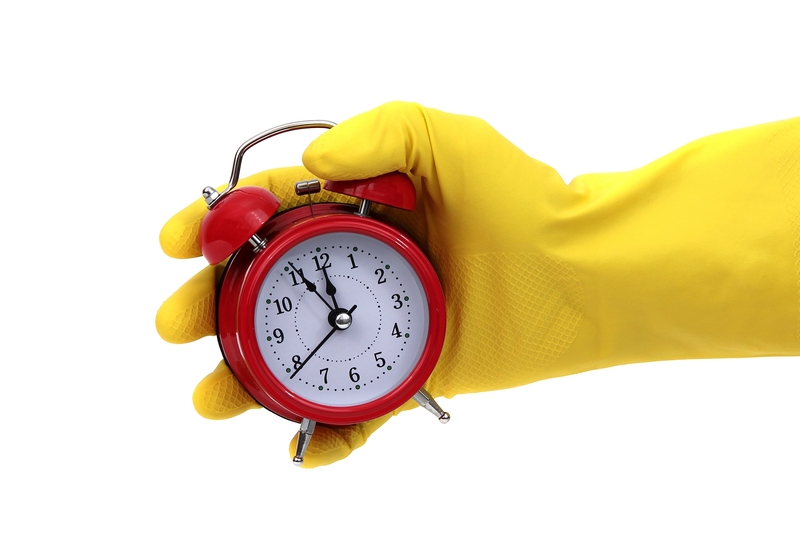Say Goodbye to Streaks: Clear Windows Done Right
Posted on 01/07/2025
Say Goodbye to Streaks: Clear Windows Done Right
Crystal-clear, streak-free windows don't just brighten up your space--they boost curb appeal, enhance natural light, and create a sparkling atmosphere indoors. Yet, countless homeowners and businesses alike struggle with window cleaning mistakes that leave smudges, haze, or residue behind. If you're tired of repeating the frustrating ritual with poor results, it's time to master the art of streak-free window cleaning. This comprehensive guide reveals expert methods, professional tricks, and proven products for spotless, gleaming windows every time.

Why Do Windows Get Streaky?
Before diving into the solutions, it's essential to understand why streaks occur when cleaning windows. Several common factors contribute to less-than-perfect glass:
- Residue from improper cleaners: Many household window sprays contain soaps or chemicals that leave a film once the water evaporates.
- Poor quality tools: Using paper towels, dirty cloths, or low-grade squeegees often drags dirt and cleaner across the glass, creating marks and lines.
- Sunlight and heat: Cleaning windows on hot, sunny days causes your cleaning solution to dry too quickly, which almost guarantees streaks.
- Incorrect technique: Random wiping or skipping steps can leave areas missed, resulting in patchy finishes and visible streaks.
By identifying the root causes, we can secure the right combination of tools, technique, and timing for pristine, streak-free window panes.
Tools You Need for Streak-Free Window Cleaning
Professional window cleaners rely on simple, effective equipment that you can find easily, too. Upgrade your window cleaning arsenal with the best tools for the job:
- Microfiber cloths: Soft, lint-free microfibers lift away dirt and polish without scratching or lint residue.
- Squeegees: Quality rubber-bladed squeegees in an appropriate size (the wider the window, the larger the blade) are essential for streak-free results.
- Soft sponge or scrubber: Use for loosening stubborn grime, especially on outdoor windows.
- Bucket: Useful for mixing cleaning solutions and rinsing tools.
- Dual-bucket system (optional): One side for soapy water, one for clean rinsing reduces contamination.
- Extension pole (for high windows): Ensures you reach upper panes safely without missing spots.
Using the correct materials makes a remarkable difference in achieving clear, streak-free finish.
Best Cleaning Solutions for Streak-Free Glass
Not all glass cleaners are created equal. The solution you use directly impacts whether your windows stay streak-free after drying. Here are some top options:
1. DIY Vinegar Solution
One of the easiest and most eco-friendly cleaners, vinegar cuts through grease and hard water stains:
- Mix equal parts distilled white vinegar and water. (Use distilled water for the absolute best results if your tap water is hard.)
- Add a drop of dish soap if tackling very dirty windows.
Tip: Never mix vinegar with bleach or ammonia-based products, as this can create harmful fumes.
2. Commercial Glass Cleaners
Shop-bought glass cleaners are effective when chosen carefully. Look for streak-free formulas specifically designed for windows, avoiding those with high soap content. Always follow manufacturer instructions.
3. Alcohol and Water Mix
- Combine 2 cups water, 1/4 cup rubbing alcohol, and 1/4 cup vinegar for a fast-drying, streak-free spray.
This blend evaporates quickly, minimizing the risk of streaks from leftover moisture.
Step-by-Step Guide: How to Clean Windows Without Streaks
Step 1: Remove Dust and Debris First
Always start by dusting the glass and surrounding frames. Dirt, cobwebs, and pollen can turn into muddy streaks if mixed with liquid cleaner. Use a soft brush, vacuum with brush attachment, or dry microfiber to wipe surfaces clean.
Step 2: Apply Your Cleaning Solution Generously
Spray (or sponge) the window with your chosen cleaner, covering the pane evenly but avoiding excessive drips. For very dirty or greasy windows, let the solution sit for a minute to break down grime.
Step 3: Scrub Gently
Use your microfiber or non-scratch scrubber to lift dirt. Focus on corners and edges, where buildup often hides. Don't scrub too hard; let the solution do the work.
Step 4: Squeegee Away the Solution
- Starting at the top corner, pull the squeegee downward in a straight line for tall windows. For wide windows, use horizontal strokes, overlapping slightly with each pass.
- Wipe the rubber blade clean after each stroke using a clean cloth.
- Continue until all solution and dirt are removed.
Pro tip: If you notice any streaks, re-squeegee the area with a clean, dry tool.
Step 5: Buff and Polish
Finish by wiping the edges, frames, and sills with a dry microfiber cloth to catch drips and catch any remaining streaks.
Window Cleaning Mistakes to Avoid
Even with great products, certain window cleaning habits can sabotage your results. Here's what to avoid:
- Cleaning in direct sunlight: Heat from the sun causes cleaner to evaporate rapidly, drying into streaks.
- Using paper towels or old rags: These leave lint and fibers that cling to glass.
- Not changing water or cloths frequently: Dirty water or cloths redistribute grime.
- Skipping the squeegee: Squeegees remove more liquid than cloth alone, reducing the risk of marks.
- Ignoring the window track and sill: Clean these areas for a thorough, professional-grade finish.
Expert Tips for Streak-Free Window Cleaning
- Clean windows on a cloudy day: Lower temperatures and indirect light give you time to work.
- Wash windows top to bottom: Dirt flows downward; avoid re-contaminating cleaned sections.
- Work indoors and outdoors: Exterior glass accumulates more tough grime; don't skip this step.
- Use vertical strokes inside, horizontal outside: If you spot a streak, you'll instantly know which side it's on!
- Dry edges and corners thoroughly: This prevents water spots and mold growth at the edges.
Special Window Types and How to Clean Them
1. Large Picture Windows
Use a larger squeegee and consider an extension pole for a single-swipe finish that minimizes edge streaks.
2. Multi-Pane or French Windows
Utilize a small squeegee and microfiber pad to navigate the muntins and avoid lines where cleaner can pool.
3. Tinted Windows
Only use cleaners without ammonia or abrasive materials. Tinted surfaces can scratch or discolor with harsh products.
4. Storm or Double-Pane Windows
Check for fogging or condensation inside the panes--a sign of sealing problems rather than outside dirt. Surface cleaning remains the same as for standard glass.
Choosing a Professional Window Cleaning Service
Sometimes, windows are large, high, or hard to reach, and a professional touch is warranted. Professional window cleaning services offer:
- Access to commercial-grade equipment and cleaning agents.
- Trained, insured staff for peace of mind and quality results.
- Expertise in hard water stain removal, paint splatter cleaning, and more.
- Regular maintenance programs to keep your windows shining all year.
If you hire a pro, ask about their streak-free guarantee and eco-friendly practices.
Maintaining Crystal-Clear Windows
Regular upkeep is crucial for consistently clear windows. Here's how to keep your glass gleaming between deep cleans:
- Monthly cleaning: Tackle the inside at least monthly; outside twice a year or after weather events.
- Spot cleaning: Address smudges from fingerprints, pets, or splashes promptly with a quick spritz and polish.
- Control condensation: Use dehumidifiers or open windows to prevent moisture buildup and minimize mold risks.
- Trim landscaping: Keep trees and shrubs pruned for less pollen, sap, or leaf debris sticking to windows.
- Install gutter guards: Reduce runoff dirtying upstairs windows with smart gutter protection.

Common Questions About Streak-Free Window Cleaning
Can I use newspaper to clean windows?
Historically, newspaper was a popular option because its texture gives a gentle polish and doesn't leave lint. However, modern inks or recycled pulp may stain glass. Microfiber cloths are safer and more effective.
How do I remove hard water stains or mineral spots?
Spray a mixture of vinegar and water on the affected area, let sit for 5-10 minutes, then scrub gently with a non-abrasive pad. For stubborn spots, commercial descalers or lime-removing products may be necessary--always check that they're safe for glass!
What should I avoid to protect my windows?
Never use sharp blades, abrasive powders, or rough sponges, especially on tinted or coated windows. These can scratch and permanently damage surfaces.
Is rainwater good for windows?
Pure rain is actually quite clean, but accumulated airborne contaminants create streaks when dried on glass. Always rinse and clean after rain for clarity.
Conclusion: Achieve Sparkling, Streak-Free Windows Every Time
Whether spring sunlight is streaming in or you want to impress guests with immaculate glass, streak-free window cleaning is well within reach for every homeowner. With the right tools, a proper cleaning solution, and expert technique, you'll never need to put up with haze, film, or annoying lines again.
Remember: Avoid cleaning windows in direct sunlight, use microfiber and a squeegee for best results, and tackle dirt regularly for an always-bright view. For especially tough jobs or hard-to-reach spots, don't hesitate to hire a professional window cleaning company that guarantees a streakless finish.
Ready to say goodbye to streaks? Start your next cleaning project with these tips for windows that gleam--and let the light shine in, clear and bright!




 Dry Carpet Cleaning
Dry Carpet Cleaning
 Mattress Cleaning
Mattress Cleaning
 Leather Sofa Cleaning
Leather Sofa Cleaning